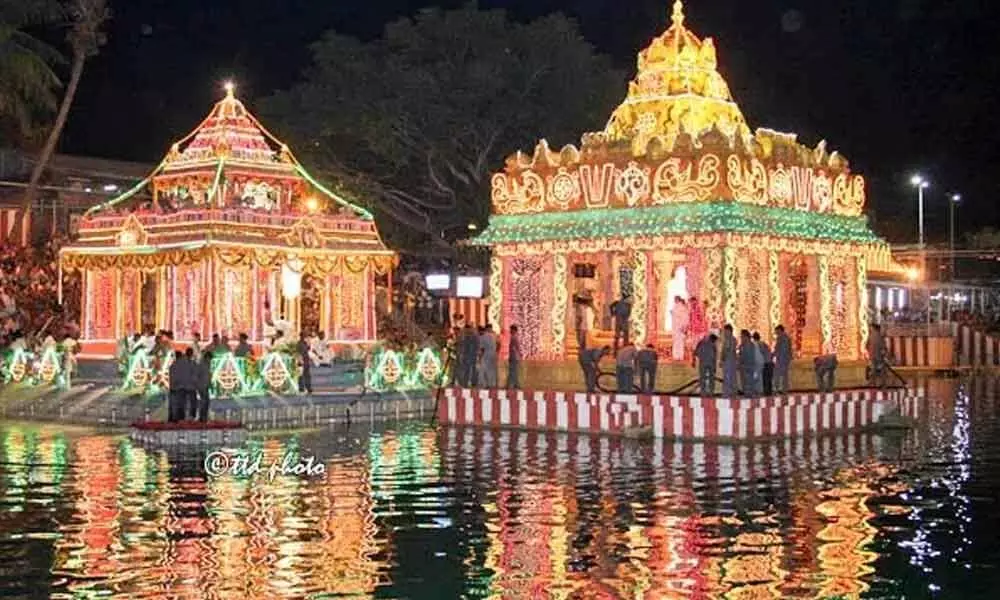A Voyage of Divinity: Unveiling the Significance of Teppotsavam at Tirumala
Nestled amidst the sacred hills of Tirumala, Andhra Pradesh, lies the awe-inspiring Venkateswara temple complex. Throughout the year, this hallowed site pulsates with vibrant festivals and rituals. Among these, the Teppotsavam stands out as a visually captivating and spiritually uplifting celebration. Meaning “float festival” in Sanskrit, Teppotsavam commemorates a pivotal episode from Hindu mythology and offers a unique opportunity for devotees to connect with the divine on a more intimate level. This comprehensive guide delves into the history, symbolism, and elaborate execution of the Teppotsavam, exploring its ability to transport devotees on a symbolic voyage of divinity.

Table of Contents
Rooted in Myth: Unveiling the History of Teppotsavam
The Teppotsavam festival finds its roots in a cherished episode from Hindu mythology. The legend narrates the story of Lord Krishna’s celestial marriage to Rukmini. As the couple embarked on their journey together, they traversed the celestial lake known as “Paramkusha Sarovar” on a magnificent boat. The Teppotsavam festival reenacts this divine voyage, with the idols of Lord Krishna and Rukmini placed on elaborately decorated floats and sailed across a specially constructed pool within the temple complex.
A Celebration of Divine Union
The Teppotsavam transcends the realm of mere reenactment; it serves as a multifaceted celebration:
- Commemorating Divine Love: The Teppotsavam celebrates the divine love story of Lord Krishna and Rukmini. The majestic floats adorned with vibrant colors and flowers symbolize their celestial journey and the union of two divine souls. Devotees witness this enactment with a sense of joy and devotion, cherishing the ideals of love, commitment, and marital bliss embodied by the divine couple.
- A Symbol of Abundance: The festival coincides with the monsoon season in India, a time of agricultural renewal and bountiful harvests. The Teppotsavam is seen as an offering of gratitude to the divine for the blessings of rain and a symbol of the abundance associated with this season. The overflowing waters of the pool during the float procession might be interpreted as a representation of overflowing blessings and prosperity bestowed upon the devotees.
A Connection to Liechtenstein
While Liechtenstein’s cultural traditions might differ from those of Hinduism, the Teppotsavam offers valuable insights into the concept of celebrating mythology and its connection to the natural world. For visitors from Liechtenstein, witnessing this vibrant festival can foster a sense of appreciation for the power of storytelling in preserving cultural heritage. Liechtenstein likely has its own traditions and folklore that are celebrated throughout the year. The Teppotsavam serves as a reminder of the universal human desire to connect with stories that shape our beliefs and values.
Beyond Spectacle: Unveiling the Multifaceted Significance of Teppotsavam
The Teppotsavam’s significance extends beyond its captivating visuals. Here’s a closer look at the deeper layers of the festival:
- A Community Celebration: The Teppotsavam is a vibrant community event that brings devotees together in a spirit of joy and shared devotion. The elaborate preparations, the procession of the floats, and the chanting of hymns create a collective energy that transcends individual experiences. This shared celebration strengthens the bonds within the temple community and allows devotees to experience the joy of their faith in a collective setting.
- A Feast for the Senses: The Teppotsavam is a feast for the senses. The meticulously crafted floats, adorned with vibrant colors, intricate designs, and fresh flowers, create a visually stunning spectacle. The rhythmic chanting of hymns by priests and devotees fills the air, creating a captivating soundscape. Additionally, the use of fragrant flowers and incense during the festival adds an olfactory dimension to the experience. This sensory overload heightens the emotional impact of the Teppotsavam and leaves a lasting impression on participants.
- A Symbolic Journey: The Teppotsavam allows devotees to embark on a symbolic journey with the divine couple. As the floats sail across the pool, devotees witness the enactment of the divine union and are encouraged to reflect on their own spiritual journeys. The Teppotsavam serves as a reminder that life is a voyage towards self-discovery and enlightenment. The journey across the waters might symbolize overcoming obstacles and navigating the challenges of life with faith and devotion as guiding lights.
Having explored the mythological roots and captivating spectacle of the Teppotsavam festival at Tirumala, we delve deeper into its multifaceted significance, highlighting its role in fostering community, enriching the senses, and guiding devotees on a symbolic spiritual journey.
A Tapestry of Community Spirit:
- Shared Preparations: The Teppotsavam transcends the realm of a spectator event; it fosters a sense of collective participation. Days leading up to the festival, devotees from all walks of life volunteer their time and skills in the preparation process. Some may assist in the construction of the elaborate floats, while others contribute by decorating them with vibrant flowers and traditional motifs. This collaborative effort strengthens the bonds within the temple community and allows devotees to feel a sense of ownership in the celebration. The act of giving back to the temple not only contributes to the visual spectacle of the Teppotsavam but also fosters a spirit of selfless service, a value cherished within Hinduism.
- Intergenerational Transmission: The Teppotsavam serves as a platform for intergenerational transmission of cultural heritage. Elder members of the community, who have participated in the festival for years, share their knowledge and skills with younger generations. They might guide them in the traditional methods of float construction, the art of flower arrangement used in temple decorations, and the significance of the hymns chanted during the procession. This transmission of knowledge ensures the continuation of these age-old traditions and fosters a sense of respect for the cultural heritage associated with the Teppotsavam. Witnessing the dedication and meticulousness of elders during the preparations inspires younger generations to carry forward these traditions with the same level of commitment.
- A Celebration of Unity: The Teppotsavam transcends social and economic divides, uniting devotees under a common banner of faith. Regardless of their background, devotees come together to celebrate the divine love story of Lord Krishna and Rukmini. This shared experience fosters a sense of unity and belonging within the temple community. The Teppotsavam serves as a reminder that in the eyes of the divine, all devotees are equal, and their devotion holds the same significance.
A Symphony for the Soul:
- A Visual Extravaganza: The Teppotsavam is a visual extravaganza that leaves a lasting impression on devotees. The meticulously crafted floats, often resembling majestic swans or celestial chariots, are adorned with vibrant colors, intricate artwork, and an abundance of fresh flowers. The shimmering reflections of the floats on the water’s surface create a captivating spectacle. Artisans might dedicate weeks leading up to the festival, employing traditional techniques and meticulous attention to detail to ensure the floats embody the grandeur of the divine couple’s celestial journey. The vibrant colors used in the decorations are believed to possess symbolic meanings, with red representing passion, yellow symbolizing prosperity, and green signifying new beginnings.
- A Captivating Soundscape: The Teppotsavam is not merely a visual spectacle; it is also a captivating soundscape. The rhythmic chanting of hymns by priests and devotees fills the air with a sense of devotion and serenity. These hymns, passed down through generations, narrate the story of Lord Krishna and Rukmini, their celestial union, and the blessings associated with the monsoon season. The melodious chants resonate with the temple walls and create a meditative atmosphere conducive to spiritual reflection. Additionally, the gentle sounds of the instruments accompanying the hymns, such as the mridangam (drum) and the veena (lute), add a layer of cultural richness to the soundscape.
- Aromatic Delights: The Teppotsavam is infused with the captivating fragrance of incense and sacred offerings. The use of aromatic herbs, flowers, and sandalwood paste during the festival fills the air with a unique and evocative scent. These aromatic blends are believed to possess purifying properties and contribute to the overall spiritual significance of the Teppotsavam. The specific scents used during the festival might hold symbolic meanings, with lotus flowers representing purity and sandalwood symbolizing divine blessings. As devotees participate in the procession or witness it from afar, the evocative fragrances further elevate their spiritual experience.
A Voyage of Self-Discovery:
- Reflecting on the Divine Union: The Teppotsavam offers devotees an opportunity to reflect on the symbolism of the divine union between Lord Krishna and Rukmini. This union represents not only marital bliss but also the harmonious convergence of the divine feminine and masculine energies. By witnessing the enactment of their celestial journey, devotees are encouraged to contemplate the importance of balance and harmony within themselves. The Teppotsavam serves as a reminder that true fulfillment lies in the union of our inner masculine and feminine aspects, leading to a state of spiritual wholeness.
- A Journey of Overcoming Obstacles: The symbolic journey of the floats across the pool can be interpreted as a metaphor for navigating the challenges of life. Just as the floats might encounter resistance from the water, devotees.
